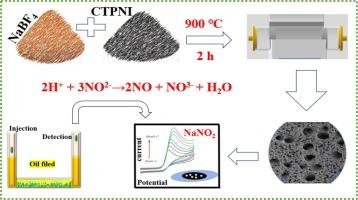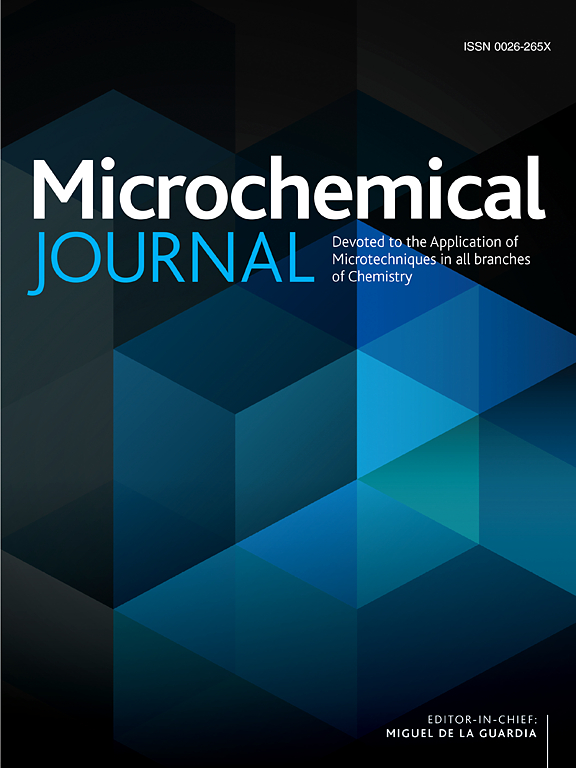Fluorine and boron co doped porous carbon materials as an electrochemical platform in trace-level sodium nitrite sensing
IF 4.9
2区 化学
Q1 CHEMISTRY, ANALYTICAL
引用次数: 0
Abstract
Sodium nitrite (NaNO2) is a common chemical oilfield tracer in the field of reservoir geological analysis. A simple, sensitive, and accurate electrochemical detection method for detection of NaNO2 has been studied. The electrode carbon porous material was based on coal tar pitch n-pentane insoluble extractants (CTPNI) and doped with the elements of fluorine (F) and boron (B) and labeled as FB-CTPNI-PC and an electrochemical sensor modified with FB-CTPNI-PC material was constructed for rapid detection of NaNO2. The characterization results of SEM and TEM indicate that this material has certain number of pore structures, also the BET analysis showed that has main pore size distribution is around the range of 2–20 nm, with abundant mesoporous structure. Moreover, the modified electrode has a good electrocatalytic effect on NaNO2. The electrochemical reaction mechanism of NaNO2 on the surface of the modified electrode was a diffusion-controlled process involving protons. The detection range of NaNO2 can reach 0.1 mM–9.5 mM. When the S/N is 3, the sensitivity is 219.8592 A·L·cm2·mol−1 and the detection limit (LOD) is 0.011 μM. The constructed electrochemical sensor has been applied to the rapid detection of NaNO2 in real oilfield water, with recovery rates ranging from 99.7 % to 103.4 %. It is also roughly consistent with the results of ion chromatography (IC) in detecting NaNO2 in oilfield water, indicating that the sensor has high accuracy. This has provided a new prospect for oil filed tracer and detection technologies.

氟和硼共掺杂多孔碳材料作为痕量亚硝酸钠传感的电化学平台
亚硝酸钠(NaNO2)是油藏地质分析领域常见的油田化学示踪剂。研究了一种简单、灵敏、准确的电化学检测方法来检测 NaNO2。以煤沥青正戊烷不溶性萃取剂(CTPNI)为基础,掺杂氟(F)和硼(B)元素的电极碳多孔材料被标记为 FB-CTPNI-PC,用 FB-CTPNI-PC 材料修饰的电化学传感器被构建用于快速检测 NaNO2。SEM 和 TEM 表征结果表明,该材料具有一定数量的孔结构,BET 分析表明其主要孔径分布在 2-20 nm 左右,具有丰富的介孔结构。此外,改性电极对 NaNO2 具有良好的电催化效果。NaNO2 在改性电极表面的电化学反应机理是一个涉及质子的扩散控制过程。NaNO2 的检测范围可达 0.1 mM-9.5 mM。当信噪比为 3 时,灵敏度为 219.8592 A-L-cm2-mol-1,检测限(LOD)为 0.011 μM。所构建的电化学传感器已应用于实际油田水中 NaNO2 的快速检测,回收率从 99.7 % 到 103.4 % 不等。在油田水中检测 NaNO2 的结果也与离子色谱法(IC)基本一致,表明该传感器具有很高的准确性。这为滤油示踪和检测技术提供了新的前景。
本文章由计算机程序翻译,如有差异,请以英文原文为准。
求助全文
约1分钟内获得全文
求助全文
来源期刊

Microchemical Journal
化学-分析化学
CiteScore
8.70
自引率
8.30%
发文量
1131
审稿时长
1.9 months
期刊介绍:
The Microchemical Journal is a peer reviewed journal devoted to all aspects and phases of analytical chemistry and chemical analysis. The Microchemical Journal publishes articles which are at the forefront of modern analytical chemistry and cover innovations in the techniques to the finest possible limits. This includes fundamental aspects, instrumentation, new developments, innovative and novel methods and applications including environmental and clinical field.
Traditional classical analytical methods such as spectrophotometry and titrimetry as well as established instrumentation methods such as flame and graphite furnace atomic absorption spectrometry, gas chromatography, and modified glassy or carbon electrode electrochemical methods will be considered, provided they show significant improvements and novelty compared to the established methods.
 求助内容:
求助内容: 应助结果提醒方式:
应助结果提醒方式:


